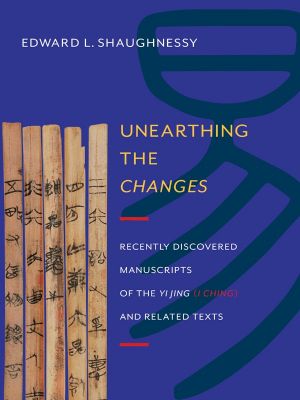Unearthing the Changes

- Authors
- Shaughnessy, Edward L.
- Publisher
- Columbia University Press
- Tags
- history , asia , china , lit008010 , literary criticism , asian , chinese , religion , his008000
- ISBN
- 9780231533300
- Date
- 2013-09-01T00:00:00+00:00
- Size
- 22.63 MB
- Lang
- en
Three archeological discoveries that reorient scholarship on early chinese civilization.
In recent years, three ancient manuscripts relating to the Yi jing (I Ching), or Classic of Changes, have been discovered. The earliest–the Shanghai Museum Zhou Yi–dates to about 300 B.C.E. and shows evidence of the text’s original circulation. The Guicang, or Returning to Be Stored, reflects another ancient Chinese divination tradition based on hexagrams similar to those of the Yi jing. In 1993, two manuscripts were found in a third-century B.C.E. tomb at Wangjiatai that contain almost exact parallels to the Guicang’s early quotations, supplying new information on the performance of early Chinese divination. Finally, the Fuyang Zhou Yi was excavated from the tomb of Xia Hou Zao, lord of Ruyin, who died in 165 B.C.E. Each line of this classic is followed by one or more generic prognostications similar to phrases found in the Yi jing, indicating exciting new ways the text was produced and used in the interpretation of divinations. Unearthing the Changes details the discovery and significance of the Shanghai Museum Zhou Yi, the Wangjiatai Guicang, and the Fuyang Zhou Yi, including full translations of the texts and additional evidence constructing a new narrative of the Yi jing’s writing and transmission in the first millennium B.C.E. An introduction situates the role of archaeology in the modern attempt to understand the Classic of Changes. By showing how the text emerged out of a popular tradition of divination, these newly unearthed manuscripts reveal an important religious dimension to its evolution.
In recent years, three ancient manuscripts relating to the Yi jing (I Ching), or Classic of Changes, have been discovered. The earliest?the Shanghai Museum Zhou Yi?dates to about 300 B.C.E. and shows evidence of the textOCOs original circulation. The Gui cang, or Returning to Be Treasured, reflects another ancient Chinese divination tradition based on hexagrams similar to those of the Yi jing. In 1993, two manuscripts found in a third-century B.C.E. tomb at Wangjiatai contained almost exact parallels to the Gui cangOCOs early quotations, supplying new information on the performance of early Chinese divination. Finally, the Fuyang Zhou Yi was excavated from the tomb of Xia Hou Zao, lord of Ruyin, who died in 165 B.C.E. Each line of this classic is followed by one or more generic prognostications similar to phrases found in the Yi jing, indicating exciting new ways in which the text was produced and used in the interpretation of divinations.
This book details the discovery and significance of the Shanghai Museum Zhou Yi, the Wangjiatai Gui cang, and the Fuyang Zhou Yi, including full translations of the texts and additional evidence that constructs a new narrative of the Yi jingOCOs writing and transmission in the first millennium B.C.E."